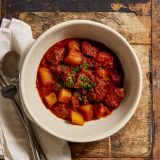Tibor Rosenstein is happy to hypothesize on the origins of goulash. Actually, spend any time at his Rosenstein restaurant—a hub of Budapest’s Jewish community—and most everyone there will happily offer their versions.
The short take: The dish—a meat and potatoes affair in a rich broth—dates back at least 1,000 years, an offshoot of Hungary’s classic but lesser-known pörkölt, a meat stew made with ample paprika.
But rather than dwell on origin stories, Rosenstein prefers to share his theory about what sets a great goulash apart. In a word—pacing!
First, a goulash primer. Like so much of Hungarian cuisine, it starts with what locals often call their holy trinity: onions cooked in fat and with enough paprika to not merely season, but even serve as a thickener. From there, meat and potatoes—and sometimes sweet root vegetables—are simmered until tender.
It seems simple, but making it sensational takes patience, Rosenstein says. As he prepares a batch for me, it’s clear this is no dump-and-simmer situation. Instead, he adds the paprika and cooking liquid in stages, each time allowing them to simmer down and thicken before adding more of each.
The impact is twofold—and brilliant. First, repeatedly reducing the liquid, each time with more paprika, produces a broth with deeply concentrated flavors—richness from the spice, sweetness from the onions and deeply savory notes from the meat. Second, adding the paprika in stages throughout cooking creates layers of flavors, each addition simmering for a different duration and therefore adding a different personality to the finished dish.
The result tastes far more complex than this simple staggering would suggest. Clearly, a dish 1,000 years old can still benefit from taking its time.
Goulash: 1,000 Years Old and Still Taking Its Time
When it comes to paprika, you need to pace yourself!
Photos: J.M. Hirsch







